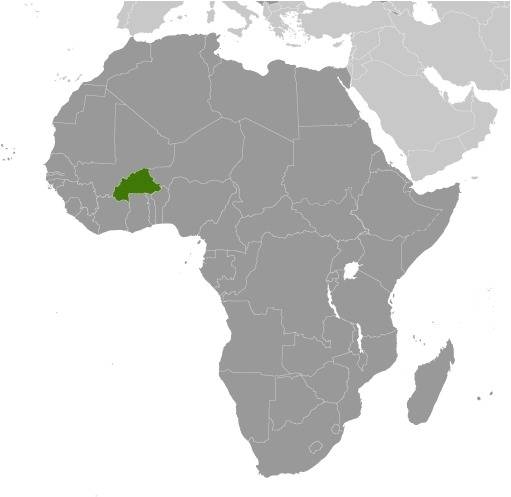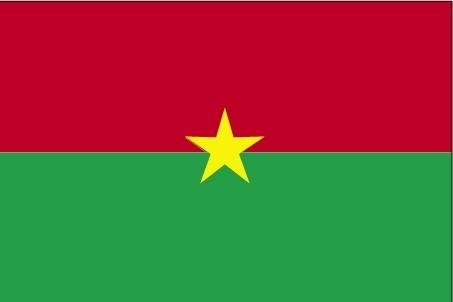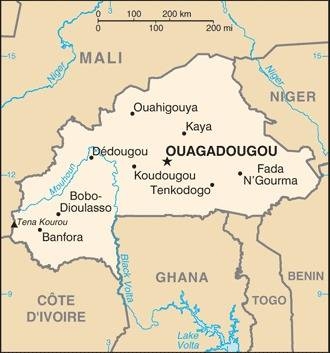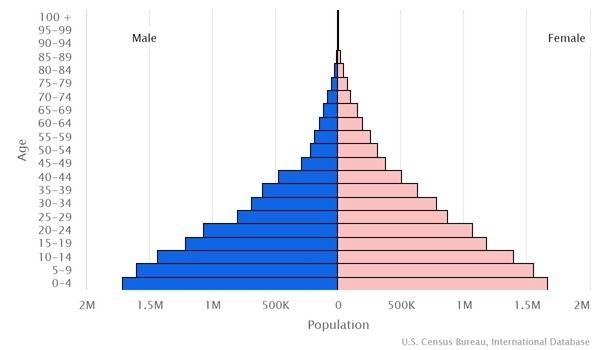Country Summary




Introduction
Background
Burkina Faso (formerly Upper Volta) achieved independence from France in 1960. Repeated military coups during the 1970s and 1980s were followed by multiparty elections in the early 1990s.
Geography
Area
total: 274,200 sq km
land: 273,800 sq km
water: 400 sq km
Climate
three climate zones including a hot tropical savanna with a short rainy season in the southern half, a tropical hot semi-arid steppe climate typical of the Sahel region in the northern half, and small area of hot desert in the very north of the country bordering the Sahara Desert
Natural resources
gold, manganese, zinc, limestone, marble, phosphates, pumice, salt
People and Society
Population
21,935,389 (2022 est.)
Ethnic groups
Mossi 52%, Fulani 8.4%, Gurma 7%, Bobo 4.9%, Gurunsi 4.6%, Senufo 4.5%, Bissa 3.7%, Lobi 2.4%, Dagara 2.4%, Tuareg/Bella 1.9%, Dioula 0.8%, unspecified/no answer 0.3%, other 7.2% (2010 est.)
Languages
Mossi 52.9%, Fula 7.8%, Gourmantche 6.8%, Dyula 5.7%, Bissa 3.3%, Gurunsi 3.2%, French (official) 2.2%, Bwamu 2%, Dagara 2%, San 1.7%, Marka 1.6%, Bobo 1.5%, Senufo 1.5%, Lobi 1.2%, other 6.6% (2019 est.)
Religions
Muslim 63.2%, Roman Catholic 24.6%, Protestant 6.9%, traditional/animist 4.2%, none 0.7%, unspecified 0.4% (2017-18 est.)
Population growth rate
2.53% (2022 est.)
Government
Government type
presidential republic
Capital
name: Ouagadougou
Executive branch
chief of state: transitional President Capt Ibrahim TRAORE (since 30 September 2022); note - on 30 September 2022, a military junta led by TRAORE, took power and ousted President Lt. Col. Paul-Henri Sandaogo DAMIBA and took over as head of the Patriotic Movement for Safeguard and Restoration.
head of government: Prime Minister Albert OUEDRAOGO (since 3 March 2022); note - transitional President Lt. Col. DAMIBA appointed OUEDRAOGO Prime Minister on 3 March 2022; the position had been vacant since 24 January 2022 when the military ousted former Prime Minister Lassina ZERBO
Legislative branch
description: unicameral National Assembly (127 seats; 111 members directly elected in 13 multi-seat constituencies by party-list proportional representation vote and 26 members elected in a nationwide constituency by proportional representation vote; all member serve 5-year terms)
Economy
Economic overview
highly agrarian, low-income economy; limited natural resources; widespread poverty; terrorism disrupting potential economic activity; improving trade balance via increases in gold exports; economy inflating after prior deflation; growing public debt but still manageable
Real GDP (purchasing power parity)
$45.16 billion (2020 est.)
Real GDP per capita
$2,200 (2020 est.)
Agricultural products
sorghum, maize, millet, cotton, cow peas, sugar cane, groundnuts, rice, sesame seed, vegetables
Industries
cotton lint, beverages, agricultural processing, soap, cigarettes, textiles, gold
Exports
$4.47 billion (2019 est.)
Exports - partners
Switzerland 59%, India 21% (2019)
Exports - commodities
gold, cotton, zinc, cashews, sesame seeds (2019)
Imports
$5.02 billion (2019 est.)
Imports - partners
Cote d'Ivoire 15%, China 9%, Ghana 8%, France 8%, India 6%, United States 5% (2019)
Imports - commodities
refined petroleum, delivery trucks, packaged medicines, electricity, aircraft (2019)
Exchange rates
Communaute Financiere Africaine francs (XOF) per US dollar -
Page last updated: Friday, December 23, 2022
